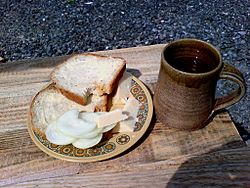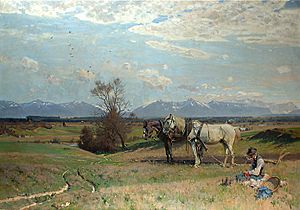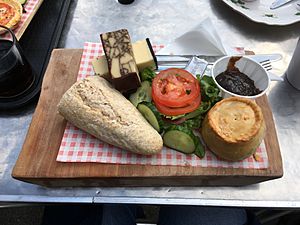Ploughman's lunch facts for kids

A ploughman's lunch consisting of bread, butter, sliced onion, wedges of cheese, and a mug of ale
|
|
| Course | main |
|---|---|
| Place of origin | United Kingdom |
| Created by | traditional ingredients, marketed by Cheese Bureau |
| Serving temperature | ambient temperature |
| Main ingredients | Bread • cheese • onion • pickle |
| Variations | ham or other cold meats |
| 965 kcal (4040 kJ) | |
A ploughman's lunch is a classic English cold meal. It usually has bread, cheese, and onions. You'll often find it served with butter and pickles. Sometimes, people add other things like ham, fresh green salad, hard boiled eggs, or even an apple. As its name suggests, it's a popular choice for lunch. You'll often find it in pubs, and it's commonly enjoyed with beer.
The idea of eating bread, cheese, and beer together has been around in England for a very long time. People have enjoyed these foods in inns for centuries. However, the exact name "ploughman's lunch" is quite new. It's thought to have started in the 1950s. At that time, the Cheese Bureau, a group that promoted cheese, began to market this meal in pubs. They wanted to sell more cheese, especially after food rationing ended. The meal became even more popular in the 1960s when the Milk Marketing Board promoted it across the country.
Contents
History of the Ploughman's Lunch
Early Meals of Farm Workers
For hundreds of years, bread and cheese were the main foods for English farm workers. These workers, often called ploughmen, relied on skimmed-milk cheese for fats and protein. Onions were a popular extra, giving flavor and important vitamin C. This simple diet was common, especially in the south of England. Even in the 1870s, farmworkers in Devon ate "bread and hard cheese" with cider for their midday meal.
While this diet showed rural poverty, it also became linked to a simple, ideal country life. The writer Anthony Trollope once wrote that a farm worker eating bread, cheese, and an onion by the roadside might enjoy it more than someone with a fancy meal.
Farm laborers usually carried their food to eat in the fields. But similar simple meals were also served in public houses. These were cheap and easy to get. In 1815, William Cobbett remembered how farmers would buy "bread and cheese" to go with their beer at inns.
The Name "Ploughman's Lunch"
The Oxford English Dictionary says the phrase "ploughman's luncheon" was first written down in 1837. This was in the Memoirs of the Life of Sir Walter Scott. But back then, it might have just meant "a lunch for a ploughman," not a specific meal.
The modern use of "ploughman's lunch" became popular much later. In 1956, the Brewers' Society (a group for beer makers) wrote about the Cheese Bureau. The Cheese Bureau wanted to make cheese popular again. They hoped to bring back the "traditional combination" of bread, beer, cheese, and pickle in pubs. This combination had been less common during and after World War II because of food rationing.
Before the 1950s, many pubs served very simple meals. In 1932, writer Martin Armstrong described stopping at country inns for bread, cheese, and beer. He noted that when there was no other choice, this simple meal tasted incredibly good.
Growing Popularity
By the 1950s, people were already using names like "ploughboy's lunch." In 1956, author Adrian Bell described a pub where you could ask for a "Ploughboy's Lunch." You would get bread, butter, cheese, pickled onions, and a pint of beer.
Just a year later, in 1957, the Brewers' Society used the exact name "ploughman's lunch." They said it included "cottage bread, cheese, lettuce, hard-boiled eggs, cold sausages and, of course, beer." By 1958, newspapers like The Bulletin and The Times also mentioned the ploughman's lunch, describing it as bread, cheese, and pickle.
The meal became very popular in the 1970s. One reason was that it was easy and quick for pubs to prepare. It didn't need cooking and had no meat, which meant pubs could make a good profit.
The film The Ploughman's Lunch (1983) uses the meal's name to talk about how countries and people sometimes change their history to fit what they need now. The film's title hints that this "traditional" meal might have been mostly created by a marketing campaign in the 1960s.
See also
 In Spanish: Ploughman's lunch para niños
In Spanish: Ploughman's lunch para niños



